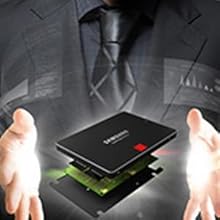





🚀 Elevate Your Storage Game!
The Samsung 850 PRO 1 TB Solid State Drive combines cutting-edge flash memory architecture with dynamic thermal protection, ensuring high performance and reliability. With a compact 2.5-inch form factor and a user-friendly installation process, this SSD is designed for professionals seeking speed and efficiency in their computing experience.









| Brand | Samsung |
| Product Dimensions | 10.01 x 7.01 x 0.69 cm; 9.07 g |
| Item model number | MZ-7KE1T0BW |
| Manufacturer | Samsung |
| Series | MZ-7KE1T0BW |
| Colour | Black |
| Form Factor | 2.5-inch |
| RAM Size | 1 GB |
| Computer Memory Type | DDR3 SDRAM |
| Hard Drive Size | 1 TB |
| Hard Disk Description | Solid State Drive |
| Hard Drive Interface | Serial ATA-300 |
| Connectivity Type | No |
| Voltage | 5 Volts |
| Wattage | 1 |
| Are Batteries Included | No |
| Item Weight | 9.07 g |
| Guaranteed software updates until | unknown |
D**
a drive
I had standard version of drive and pro version is faster very good drive.I format and check bios myself so all great.It is value for money it's solid in construction so not the lightest SSD but metal rather than plastic.Also read write function is faster than any or most normal plater hard drive. Very happy long life thank you. I have had a slight problem after testing the drive Samsung software should recognise drive but its saying na not applicable Also different name i don't care more testing will be done but shows they are faking SSD and SD cards on net. if i get any further i will amend review.... This is problem with second hand goods....
J**L
Super Speedy Samsung SSD - once again...
I currently own the Samsung 830 256GB SSD, and after coming to the upper limits of its storage, it was time to expand (only had 4GB remaining!). First choice was the 850 Pro, with its higher IOPS range, reflected by Samsung's 10 year warranty guarantee.Physically, the 850 Pro is not as good looking as the 830, which had a brushed aluminium finish. The chrome trim remains however, so at least it will look unified once installed into the system.I was disappointed with the package given the price; the 850 Pro comes with no SATA cable, or SATA to USB cable, unlike the 830 - only the Samsung Magician CD (which would probably be more up-to-date on the Samsung website), and installation instructions. It would be nice to see at least one SATA cable packaged with Samsung SSDs, for newcomers etc - and just to save the expense of buying an extra cable.Coming onto installation, it was very simple; but my installation of Windows is strategically split into two - one partition for Windows, and another for Programs, which is a habit from my XP days, but also makes modifications to storage very easy. Using this method, it ensures that I do not modify or damage anything to do with Windows.Subsequently, I cloned the Programs (E:) partition to the 850 Pro, using Macrium Reflect, and then expanded the partition to the full storage capacity using AOEMI Partition Assistant. The drive letters were then re-ordered for Windows, with the 850 Pro taking up the Programs (E:) position from the 830.A reboot was all that was needed, Windows did not flinch at all, and I re-consolidated the extra space on the 830 to the Windows partition. So now I have one SSD for Windows, and another for Programs.The performance of the drive is very good; using Samsung Magician to run a performance test, the read speed clocked in at 564MB/s, while the write speed clocked in at 518MB/s. Obviously this a brand new drive, but even with constant use, the 850 Pro should hold up really well, given my past experience with the 830, which still reads/writes at 540/378 respectively, even after 2.5 years, where I have written 8TB in total.The CAD programs I depend on can get quite hefty in size (with multiple plugins, add-ons etc), and I have no doubt that the 850 Pro is up to the challenge, especially with RAPID Mode (present also on the 840 series) which is dependent on RAM size and speed - but bear in mind that it is more akin to a tuned version of Windows SuperFetch.Samsung are beginning to come into a league of their own with storage solutions, and with its performance, reliability, and relatively decent price ranges, it is not a surprise.I have no hesitation in recommending this speedy drive.
N**D
A nice performance boost to my Desktop PC
I've included below some tips and tricks that some people might find useful (albeit very long). The executive summaryis that it all worked okay, with a minor hoop to jump through with cloning from my HDD to the SSD. Also, turning on AHCIgave me a performance boost, but you have to enable it properly in Win 7 before turning it on in the BIOS.Installation:When I read the installation instructions leaflet (all diagrams, no text), it indicates youshould connect your SSD via a USB-to-SATA adapter (not supplied) and then perform thedata migration (cloning). In fact, the USB adapter isn't required - I installed the driveinternally in my PC and the cloning software worked okay (see below).On the supplied CD there are two pieces of software - Data Migration and Magician software.I ran the exe in the top directory of the CD drive and it gave me option to install bothpieces of software at once. I'm not sure if I missed something, but it only seemed to installthe Magician software. A quick navigate to the Data Migration directory and runningan exe I found there quickly remedied that issue.Cloning:The Data Migration software is very simple and only gives you the option to migrateall the partitions from your existing drive to the SSD and not a subset. I havea 500Gb drive on which I had a C: 120Gb Win7 OS partition, that I wanted to migrate, but alsoa D: partition that I didn't. However, all you get is a "Start" button. So I exitedthe Data Migration software, removed the D: drive letter assignment (via diskmgmt.msc),and re-run the Data Migration. This time, it only showed the C: drive on my source diskas a migration to the SSD, and I went ahead and clicked Start. The migration took about 15 mins or so,with my source partition being about half full, after which I re-added the D: drive letter assignment.Note that the Data Migration software gives a scary message saying that it will not migrate any openfiles, leaving you wondering whether the OS files - many of which are presumably open -will ever get migrated. However, it all seemed to work okay when I finally booted the SSD.Rebooting with the SSD:After the cloning had finished, I rebooted and this is where things went wrong for me(temporarily). I had run up the Magician software just before cloning, and it had mentionedin its home screen (where it shows the drive status etc) that turning on AHCI modeimproves performance. I made the mistake of rebooting into the BIOS, changing the primaryboot device to be the SSD (fine) but also turning on the AHCI mode at the same time (mistake).Rebooting gave a Windows boot error with the option of ""Launch Repair" or "Start Windows Normally".I didn't know what was going on at this point - whether it was the cloning gone wrong or what.I didn't realise at the time that, for Win 7 at least, you have to go through a procedureto enable the AHCI driver first (see below). After resetting my system to disable AHCI andrebooting, I still got the boot error but, upon choosing "Start Windows Normally" my systemcame up (very speedily!). I don't know if I would have got that boot error regardlessof turning on AHCI.Performance Testing and AHCI:Well so far, after a day, it's okay and I'm writing this review using my Win 7 OS cloned onto theSSD. Magician includes some some benchmarks that I ran and have given the results below (my system isa Gigabyte Z77M with a Core i3 i3225). I tested with and without AHCI. Enabling AHCI in Win 7(do this before changing it in the BIOS!) involves either installing an update from MS or, as Ichose, changing a registry entry, rebooting with AHCI disabled, then rebooting with AHCI enabled.Rhese are the results I got with and without AHCI, and also setting 10% Over-Provisioning (OP) in Magician:AHCI off, no OP:Seq Read/Write (MB/s): 439 / 443Random Read/Write (IOPS): 8972 / 27846AHCI on, no OP:Seq Read/Write (Mb/s): 541 / 515Random Read/Write (IOPS): 57180 / 60880AHCI on, OP 10%:Seq Read/Write (Mb/s): 564 / 525Random Read/Write (IOPS): 63129 / 60400Results speak for themselves. However, there was a very minor degradation in theseq write performance of my existing HDD (Seagate 7200.14 500Gb) when I turned on AHCI (100 -> 96):AHCI off:Seq Read/Write (Mb/s): 75 / 100Random Read/Write (IOPS): 170 / 287AHCI on:Seq Read/Write (Mb/s): 77 / 96Random Read/Write (IOPS): 314 / 290I think I can live with that.Final tip - I don't use Hibernation any more - don't need to as the ordinary system boot is so fast but, also, it can end up writing a large amount of data and therefore using up your Total Bytes Written just that little bit faster.Overall, I'm pleased with the drive and software - I hope it lasts the distance!
Trustpilot
2 weeks ago
1 month ago